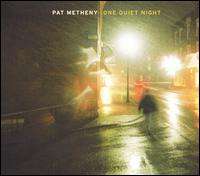One Quiet Night
One Quiet Night is a solo acoustic guitar album by Pat Metheny that won the Grammy Award for Best New Age Album in 2004.[4] He recorded the album at his home studio on a baritone guitar built for him by Linda Manzer.
| One Quiet Night | ||||
|---|---|---|---|---|
 | ||||
| Studio album by | ||||
| Released | May 13, 2003 | |||
| Recorded | November 24, 2001 and January 2003 | |||
| Genre | Jazz, folk jazz, crossover jazz | |||
| Length | 65:35 | |||
| Label | Warner Bros. | |||
| Producer | Pat Metheny, Steve Rodby | |||
| Pat Metheny chronology | ||||
| ||||
| Review scores | |
|---|---|
| Source | Rating |
| Allmusic | |
| All About Jazz | [2] |
| Encyclopedia of Popular Music | |
In the liner notes, Metheny called One Quiet Night a homemade album that was recorded with one guitar, one microphone, and mistakes. Most of the album was recorded in one day, November 24, 2001, with additional recording in January 2003. He included two of his favorite songs, "My Song" by Keith Jarrett and "Ferry Cross the Mersey" by Gerry and the Pacemakers, and a more recent favorite, "Don't Know Why" by Jesse Harris, made popular by vocalist Norah Jones; "Last Train Home", which he had been playing on baritone guitar during a tour; and two new songs, "Song for the Boys" and "Over on 4th Street". Metheny produced the album and Steve Rodby was co-producer.[5]
Track listing
All tracks are written by Pat Metheny except where noted.
| No. | Title | Length |
|---|---|---|
| 1. | "One Quiet Night" | 5:01 |
| 2. | "Song for the Boys" | 4:31 |
| 3. | "Don't Know Why" (Jesse Harris) | 3:08 |
| 4. | "Another Chance" | 6:54 |
| 5. | "Time Goes On" | 3:19 |
| 6. | "My Song" (Keith Jarrett) | 4:22 |
| 7. | "Peace Memory" | 6:12 |
| 8. | "Ferry Cross the Mersey" (Gerry Marsden) | 3:58 |
| 9. | "Over on 4th Street" | 3:41 |
| 10. | "I Will Find the Way" | 7:51 |
| 11. | "North to South, East to West" | 12:03 |
| 12. | "Last Train Home" | 4:35 |
| 13. | "In All We See" | 6:40 |
Note
- Track 13 is a bonus track available on the 2009 Nonesuch Records reissue.[6]
Personnel
- Pat Metheny – baritone guitar
Awards
| Year | Category |
|---|---|
| 2004 | Grammy Award for Best New Age Album |
References
- Collar, Matt. "One Quiet Night – Pat Metheny | AllMusic". allmusic.com. Retrieved 18 July 2011.
- Lowe, Farrell (25 June 2003). "Pat Metheny: One Quiet Night". allaboutjazz.com. Retrieved 17 October 2013.
- Larkin, Colin (2007). Encyclopedia of Popular Music (4th ed.). Oxford University Press. ISBN 978-0195313734.
- "One Quiet Night – Pat Metheny". AllMusic. Retrieved 13 January 2017.
- Metheny, Pat (2003). One Quiet Night (booklet). Warner Bros. p. 1.
- "One Quiet Night by Pat Metheny". Nonesuch Records. Nonesuch Records. Retrieved 23 January 2018.